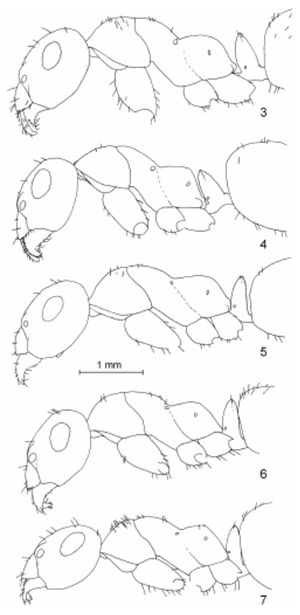Key to Formica rufibarbis group
This worker key is based on: Seifert, B. and R. Schultz. 2009b. A taxonomic revision of the Formica rufibarbis Fabricius, 1793 group (Hymenoptera: Formicidae). Myrmecologische Nachrichten. 12:255-272.
The complex Numobat procedures presented in this paper are indispensable for safe and testable species delimitations but we are aware that these are not easily reproducible by the majority of practitioners doing ecological and faunistic research. As a consequence, we present here a simplified dichotomous key which should enable determinations in the majority of cases. We have tried to find a less time-consuming determination method by strongly reducing the number of required characters and using primary (uncorrected) data. The entry values in the key are arithmetic means of usually three workers per nest. The error estimations given in the discriminant functions refer to this sample size and our accuracy of data recording. To reduce working time when using discriminant functions, we recommend beginning with one worker per sample and only extending the sample size when the resulting discriminant value is close to zero.
You may also be interested in
1
- Unilateral number of standing setae on underside of head 0.7 - 2.8. Petiole scale wide, PEW / CS 0.483 ± 0.017. Eye large, EYE / CS 0.303 ± 0.010. Head short, CL / CW 1.110 ± 0.018. 40 - 90% of mesosomal surface dark brown. Dorsal mesosoma always with setae. Asia Minor (Taurus Mountains) only (Fig. 8) . . . . . Formica anatolica
- Unilateral number of standing setae on underside of head 0 - 0.7. Character combination of petiole width, eye size and head shape different. . . . . . 2
2
return to couplet #1
- Distance between transverse microripples on dorsum of 1st gaster tergite very large: RipD 7.9 ± 0.5 μm. Pronotum hairy: nPN 9.2 ± 2.2. Head and scape elongated: CL / CW 1.174 ± 0.018, SL / CS 1.089 ± 0.021. Petiole scale narrow: PEW / CS 0.382 ± 0.018. Head and mesosoma usually reddish yellow. So far only known from the Tarim Basin (Fig. 7) . . . . . Formica tarimica
- Distance between transverse microripples on dorsum of 1st gaster tergite smaller – if occasionally approaching 7.9 μm (in F. orangea sp.n.), then CL / CW and SL / CS clearly smaller. . . . . . 3
3
return to couplet #2
- 87 - 100% of mesosomal surface orange and distance of transverse microripples on dorsum of 1st gaster tergite large: RipD 6.7 ± 0.5 μm. Head and scape rather short: CL / CW, 1.115 ± 0.017, SL / CS 1.027 ± 0.026. Dry steppes and semideserts from 58° to 104° E (Fig. 6) . . . . . Formica orangea
- Character combination different. If mesosomal surface with more than 85% light reddish pigmentation, then RipD < 5.5 μm. . . . . . 4
4
return to couplet #3
- Whole body with numerous standing setae: nPN 10.9 ± 2.9, nMN 6.6 ± 2.8, nPE 3.8 ± 1.1, nHFFL 3.4 ± 1.4 (Fig. 3). Discriminant 0.187 * nPN + 0.041 * nMN + 0.769 * nPE + 0.726 * nHFFL + 0.007 * nPRME - 4.644 * CL + 2.838 > 0 [CL in mm, error rate 0.5%] . . . . . Formica rufibarbis
- Whole body with fewer standing setae: nPN 1.7 ± 1.8, nMN 0.7 ± 1.0, nPE 0.4 ± 0.5, nHFFL 0.5 ± 0.5. Discriminant 0.187 * nPN + 0.041 * nMN + 0.769 * nPE + 0.726 * nHFFL + 0.007 * nPRME - 4.644 * CL + 2.838 < 0 [CL in mm, error rate 0.5%]. . . . . . 5
5
return to couplet #4
- Distance between transverse microripples on dorsum of 1st gaster tergite large: RipD 6.0 ± 0.4 μm. . . . . . 6
- Distance between transverse microripples on dorsum of first gaster tergite smaller. . . . . . 7
6
return to couplet #5
- Scape long: SL > -1.248 * CW2 + 3.774 * CW - 1.27 [all measurements in mm]. Dorsal crest of petiole scale often obtuse-angled. North Iran (Fig. 10) . . . . . Formica persica
- Scape shorter: SL < -1.248 * CW2 + 3.774 * CW - 1.27. Central Asian mountains from 71° to 109° E and 33° to 47° N (Fig. 9) . . . . . Formica tianshanica
7
return to couplet #5
- Scape extremely long: 0.01986 * CW + 1.4442. E China from 99° to 116° E and 27° to 40° N (Fig. 11) . . . . . Formica glabridorsis
- Scape shorter: SL / CW < -0.01986 * CW + 1.4442. . . . . . 8
8
return to couplet #7
- Whole body often darker pigmented with stronger pigmentation contrast on genae (Fig. 1); discriminant with error rate 3.4%: 0.066 * PIGM + 2.014 * CONT + 1.641 * SL - 5.891 > 0. Discriminant with error rate 0.4%: 54.173 * EYE - 7.026 * CW - 3.675 * SL + 896 * RipD + 0.065 * PIGM + 1.624 * CONT - 15.0054 > 0. Usually in moderately xerothermic habitats with more developed herb layer (Fig. 4). Missing from Pakistan and India . . . . . Formica cunicularia
- Whole body usually light reddish brown with weak or missing pigmentation contrast on genae (Fig. 2); discriminant with error rate 3.4%: 0.066 * PIGM + 2.014 * CONT + 1.641 * SL -5.891 < 0. Discriminant with error rate 0.4%: 54.173 * EYE - 7.026 * CW - 3.675 * SL + 896 * RipD + 0.065 * PIGM + 1.624 * CONT - 15.0054 < 0. Usually in more xerothermic habitats with weakly developed herb layer (Fig. 5). Also in Pakistan and India . . . . . Formica clara

















